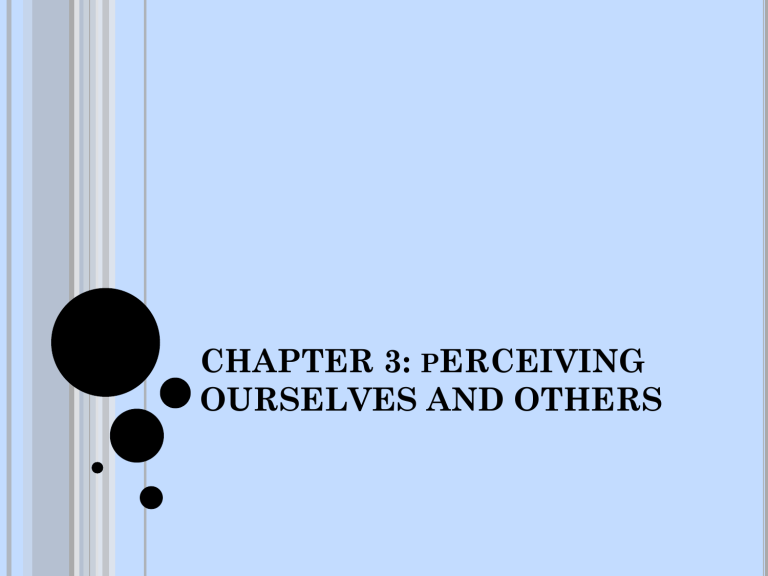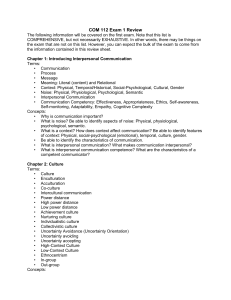
CHAPTER 3: PERCEIVING OURSELVES AND OTHERS LEARNING OBJECTIVES 3.1 Perceives Ourselves 3.1.1 Self-Concept 3.1.2 Self-Enhancement 3.1.3 Self-Verification 3.1.4 Self-Evaluation 3.1.5 The Social Self 3.2 Perceiving The World Around Us 3.2.1 Model of The Perception Process 3.2.2 Specific Perpetual Processess And Problems (Errors/Distortion in Perception ) 3.3 Improving Errors in Perception 3.1 SELF-CONCEPT: HOW WE PERCEIVE OURSELVES What is selfconcept? An individual’s self-belief and self evaluation 3.1.1 SELF-CONCEPT: HOW WE PERCEIVE OURSELVES (CONT) 3 characteristics of self-concept Complexity – different roles at various time Clarity – the degree to which you have clear and confidently defined selfconcept Consistency – individual’s self- perceived roles require similar personality traits, values and other attribute SELF-CONCEPT: HOW WE PERCEIVE OURSELVES (CONT) 4. Social self Set of attribute that highlight the personal identity and social identity 3. Self-evaluation The way you value yourself base on your self-esteem, selfefficacy and locus of control Self-esteem – the extent to which you like, respect and satisfied with yourself Self-efficacyperson’s belief that he/she can successfully complete a task 1. Self-enhancement Motivation to have a positive self-concept and improve themselves 4 processes that shape self-concept: 2. Self-verification A person’s inherent motivation to confirm and maintain the existing selfconcept Locus of control – belief about the amount of control he/she has in personal life SELF-CONCEPT: HOW WE PERCEIVE OURSELVES (CONT) Implication of self-concept in organizational behavior Decision process and bias Understanding employee’s perception Employee motivation Team dynamics Leadership development Job stress Job performance 3.2 PERCEIVING THE WORLD AROUND US What is perceptual process? Process of receiving information about and making sense of the world around us 3.2.1 MODEL OF PERCEPTUAL PROCESS Environmental stimuli Selective attention and emotional marker response Perceptual organization and interpretation Attitudes and behavior MODEL OF PERCEPTUAL PROCESS (CONT) Environmental stimuli Perception begins when environmental stimuli are received through our senses such as feeling, hearing, seeing, smelling, tasting Selective attention and emotional marker response Process of attending to some info received by our senses and ignoring info. E.g.: attention towards flashing red light, awareness Perceptual organization and interpretation Interpretation is process of making sense of the world around us which include the categorical thinking (organizing people and objects into preconceived categories that are stored in our long-term memory) MODEL OF PERCEPTUAL PROCESS (CONT) Perceptual organization and interpretation (cont) In the making sense process, it’s require a mental model (knowledge structures that we develop to describe, explain, and predict the world around us). 3.2.2 PERCEPTUAL PROCESS AND PROBLEMS Perceptual process are specific sub processes and associated biases and other errors Stereotyping in organization Attribution theory Self-fulfilling prophecy Other perceptual effect STEREOTYPING IN ORGANIZATION What is stereotyping? Process of assigning traits to people based on their membership on a social category STEREOTYPING IN ORGANIZATION (CONT) Occurs because: Categorical thinking (nonconscious process of organizing people and object into preconceived categories that are stored in long term memory) Innate drive to understand and anticipate others’ behaviour Enhances our self-concept (self-enhancement and social identity): Categorization – categorising people into distinct group Homogenization – to simplify the comparison process, we tend to think that people within each group are very similar Differentiation – we tend to assign more favourable characteristic to people in our group that to people in other group STEREOTYPING IN ORGANIZATION (CONT) Problem with stereotyping: Overgeneralises, i.e. does not represent everyone in the category Basis of systemic and intentional discrimination Overcoming stereotype biases Difficult to prevent stereotype activation Possible to minimise stereotype application Increase awareness and understanding about people differences ATTRIBUTION THEORY What is attribution process? A perceptual process of deciding whether and observed behavior/event is caused largely by internal and external factors. ATTRIBUTION THEORY (CONT) Attribution process refers to a belief about the causes of behavior/event is due to: Internal factors – person’s characteristic, ability External factors – resources, coworker support etc Importance to understand the attribution theory: To understand the cause-and-effect relationship to ensure the effectiveness of teamwork Avoid perceptual error Improve and make correction ATTRIBUTION THEORY (CONT) Internal factors High consistency Low Distinctiveness Low consensus Consistency in performing the work in the same situation/ material/ equipment Distinctiveness in performing the work in different situation/ material/ equipment Do other people performing the same performance? High consistency High Distinctiveness High consensus External factors Performance ATTRIBUTION THEORY (CONT) Attribution errors: Self-serving bias The tendency to attribute our favorable outcome to internal factors and our failures to external factors Fundamental attribution error Tendency to see people rather than the situation as the main cause of the person’s behavior SELF-FULFILLING PROPHECY What is selffulfilling prophecy? The perceptual process in which our expectations about another person cause that person to act more consistently with those expectation SELF-FULFILLING PROPHECY (CONT) Self-fulfilling prophecy circle: SELF-FULFILLING PROPHECY (CONT) Contingencies of selffulfilling prophecy: Beginning of relationship When several peoples hold the same expectation Among people with a history of low achievement because they are more easily influenced by others OTHER PERCEPTUAL EFFECTS HALO EFFECT When our general impression of a person, usually based on one prominent characteristic, distorts our perception of other characteristic of that person Halo effect is reinforced by the primacy effect OTHER PERCEPTUAL EFFECTS (CONT) FALSE CONSENSUS EFFECT / SIMILAR-TO-ME EFFECT People overestimate the extent to which others have similar beliefs/behavior to our own OTHER PERCEPTUAL EFFECTS (CONT) PRIMACY EFFECT Perceptual error in which we quickly form an opinion of people based on the first information we receive about them OTHER PERCEPTUAL EFFECTS (CONT) RECENCY ERROR Perceptual error in which the most recent information dominates our perception of others 3.3 IMPROVING ERROR IN PERCEPTION Knowing about the perceptual bias. Awareness of perceptual bias HOW TO IMPROVE PERCEPTION ?? Any activity in which people engage in valued activities which indirectly improve selfawareness and mutual understanding Increase awareness through training, sharing knowledge Improving selfawareness Aware about our belief, values and attitudes Meaningful interactions Increase selfawareness by applying the Johari Window IMPROVING PERCEPTION Johari Window Model of Self-Awareness and Mutual Understanding The Johari Window is a communication model that is used to improve understanding between individuals. The word 'Johari' is taken from the names of Joseph Luft and Harry Ingham, who developed the model in 1955.






